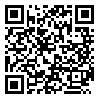BibTeX | RIS | EndNote | Medlars | ProCite | Reference Manager | RefWorks
Send citation to:
URL: http://hii.khu.ac.ir/article-1-2580-en.html
Background and Aim: This study aims to investigate and clustering the information needs and information seeking behavior of seminary and university students using neural network analysis in Khorasan-e- Razavi.
Methods: The quantitative study is an applied and descriptive survey conducted with neural networks analysis. Data were collected by a questionnaire based on the information needs and information seeking behavior of seminary and university students of Khorasan-e- Razavi province. It was distributed between the samples (447 samples) included of Mashhad, Sabzevar and Gonabad University of Medical Sciences faculty members, and four grade seminary students of Nawab, Ayatollah Khoui and Narjes religious schools. After collecting data, the two variables of university and religious schools students were apart for data clustering using Matlab 14 software once in general based on the main components of the study such as (the purpose and the motivation of seeking information, information sources, information barriers, information seeking skills, seeking methods and information services. Then, after deleting each sub-component of the main components of the research, the most effective and the least effective item on information needs and information seeking behavior of seminary and university students were determined.
Results: the most effective component in motivating and aim of the students for information seeking in seminary students was to help them conduct research on cultural and religious activities and in university students was to improve the quality of their teaching. The least effective component in both seminary and university students were determined as academic reputation and compete with peers.
The most effective component of the resources required by both seminary and university students were Persian full-text electronic journals. The least effective needed resources in seminary students were determined Latin books and in university students were determined theses. The most effective way to access information in the seminary schools was print resources and in university students was electronic resources and the least effective way was determined as buying needed resources. Both seminary and university students in the most and least effective component in information services in meeting their required information needs were common and the same. The most services in meeting their information needs were familiarity with a variety of resources in their special field and least effective component was determined as familiarity with RSS and podcasts.
Conclusion. According to the aim and findings of this study, by determining information seeking behavior that descends from information needs, preparing required sources for seminary and university student is one of the most important needs that must be done to solve their informations needs and provide information deciding for libraries administrators.
| Rights and permissions | |
 | This work is licensed under a Creative Commons Attribution-NonCommercial 4.0 International License. |






